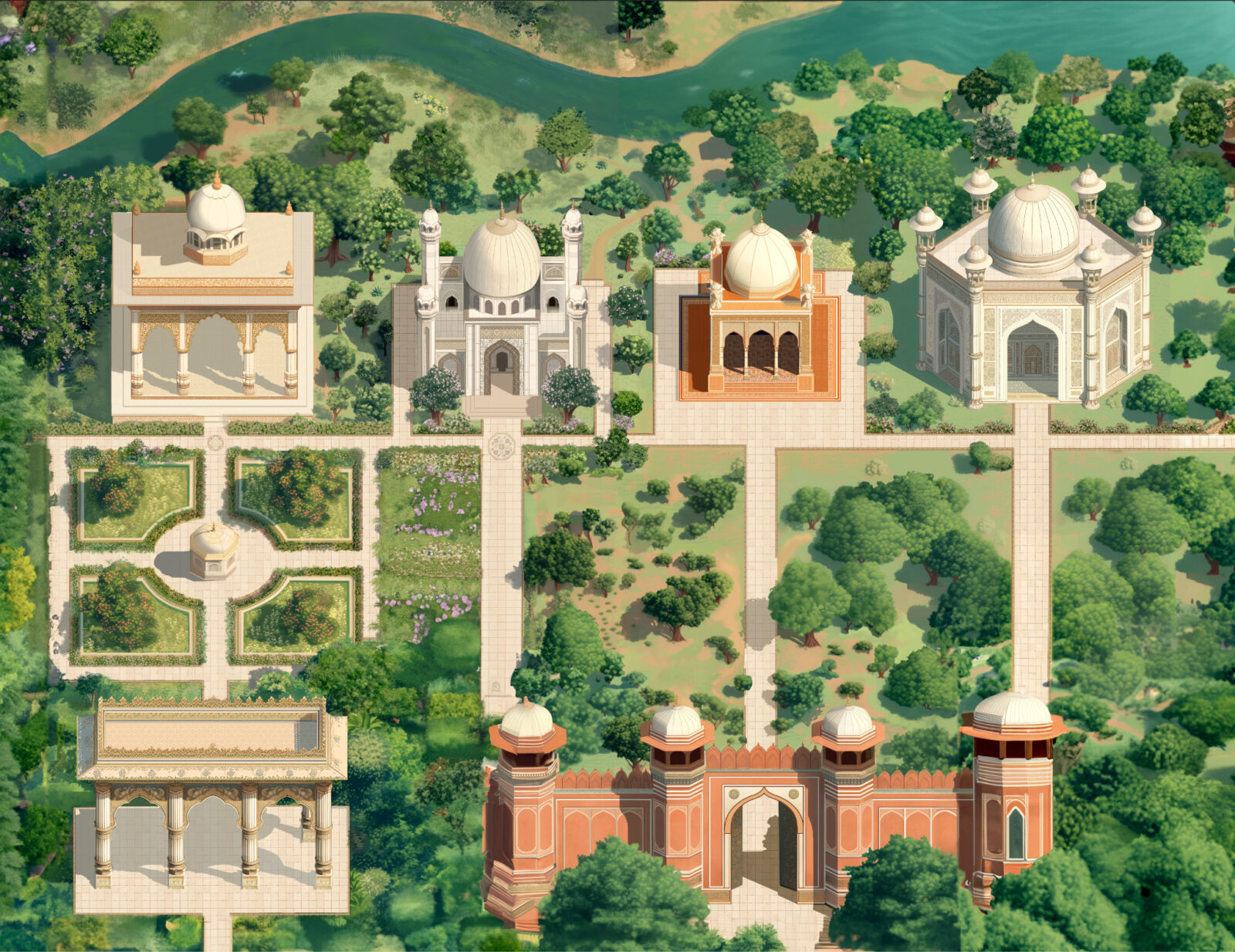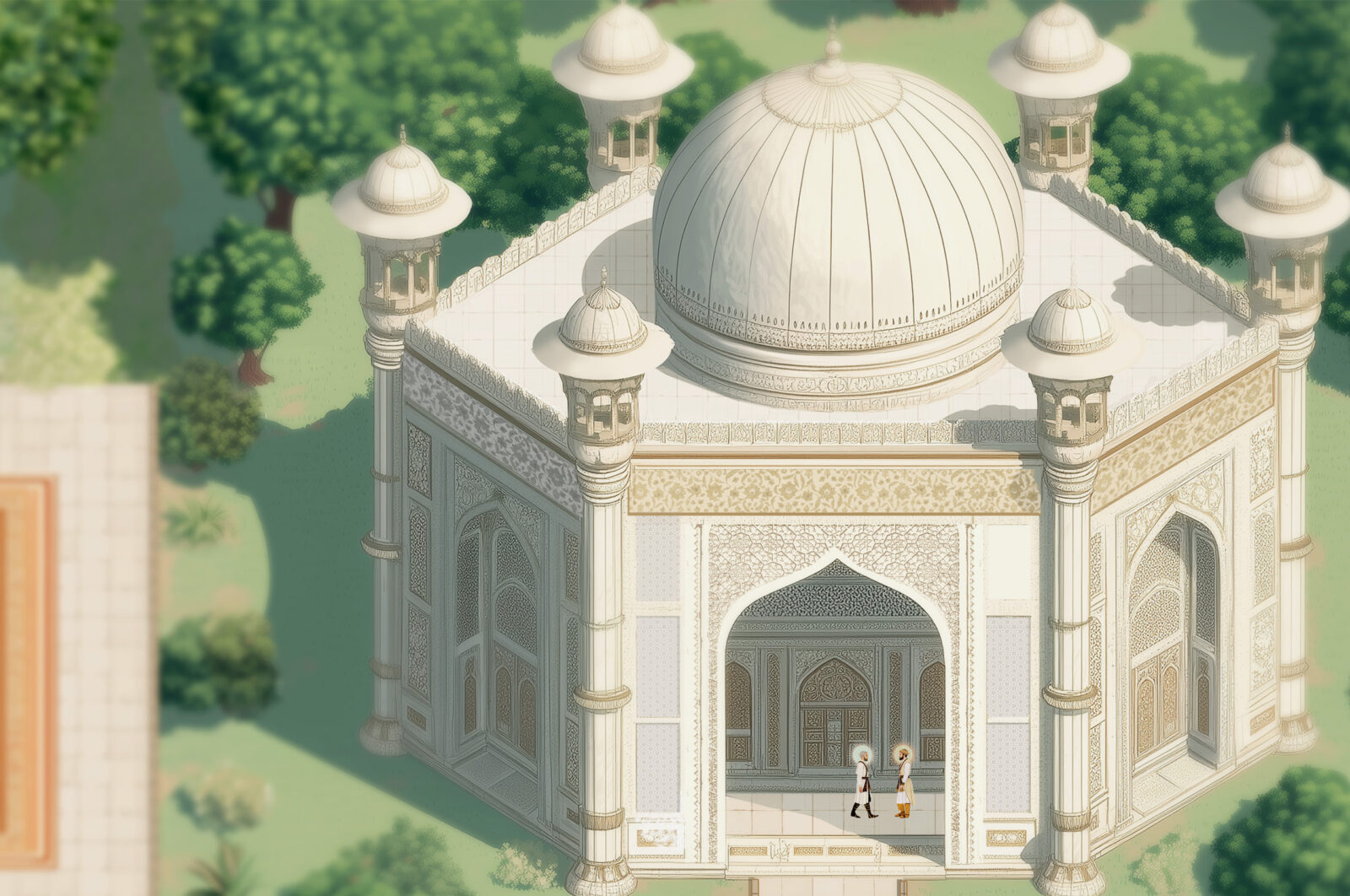Commissioned by the Los Angeles County Museum of Art (LACMA) and premiered at the Serendipity Arts Festival in Panjim, Goa, India, The Game of Whispers is a five-channel audiovisual installation and video game that reimagines the artistry of Mughal miniature painting through the lens of artificial intelligence.
Set within a reimagined version of Delhi’s historic Red Fort, the piece parallels the political intrigue of Shah Jahan’s court with the role of AI in shaping modern disinformation. By weaving together historical narratives and generative storytelling, the work explores how rumors, manipulation, and shifting power dynamics—once wielded by emperors and courtiers—now echo in increasingly digital world. The artwork highlights the ways technology distorts truth, raising urgent questions about the mechanics of influence, both past and present.
Level Design
The game’s level design translates the architecture of Delhi’s historic Red Fort into an expansive, navigable map that captures the complexity and scale of Mughal-era design. Key structures—including mosques, gardens, public and private halls, and the emperor’s palace—have been incorporated to ground the world in historical authenticity.


Thousands of generative images were produced to develop a distinct visual language inspired by classic 2D games, Mughal miniature paintings (particularly those in LACMA’s collections), and the fort’s intricate, colorful architecture. While the foundation is AI-generated, the final map has been carefully refined by hand, ensuring a richly detailed environment.

Character Design (AI NPCs)
For the initial installation of the work at Serendipity Arts Festival, audiences follow the interconnected storylines of five distinct NPCs—game characters not controlled by players but powered by advanced large language models, similar to those that run chatbots like ChatGPT. As they spread rumors and react to unfolding events, viewers witness how a single falsehood can ripple through the palace, shaping relationships and influencing decisions.

The characters are directly drawn from Mughal miniature paintings, with figures meticulously extracted in Photoshop, animated using AI, and seamlessly integrated into the game world. This process allows historical imagery to take on new life, transforming static figures into dynamic agents of intrigue and deception.
Technology
The technology powering The Game of Whispers is the first of its kind. Mital’s creative technical studio, The Garden in the Machine Inc., has created custom technology for crafting and bringing autonomous characters to life inside games.
The avatars are imbued with unique personalities, engage in lifelike conversations, and independently navigate their digital worlds. Each time a simulation or a game starts, an entirely unique series of events occurs. The NPCs are given the ability to “see,” “hear,” and “understand” what’s happening around them. Ultimately, this allows for misinformation to spread and for emergent, dynamic behavior to immerse viewers/players in the game.
Gameplay
For the initial installation of the work with five audiovisual channels, each screen follows a different character.

In this simulation, we can see many examples of dynamic conversation, the spread of misinformation, and even dramatic events.
Installation at Serendipity Arts Festival
The installation at Serendipity Arts Festival in December 2024, where the work launched, was enjoyed by audiences of all backgrounds and ages for its immersive blend of history, AI, and interactive storytelling. Visitors engaged with the richly detailed world, witnessing how narratives unfold through the actions of AI-driven characters within the reimagined Red Fort.
While the current iteration offers a dynamic audiovisual experience, the project is still being developed to enhance interactivity, allowing for deeper engagement with the characters, environment, and evolving storylines, and will be exhibited further in 2025.
Collaborators
Breanna Browning, Arturo Castro, Seth Rosetter, Jacobo Heredia Zurita, Ruipeng Wang, Sanaya Ardeshir, Krishna Jhaveri, Udit Duseja, Maria Kuraeva



